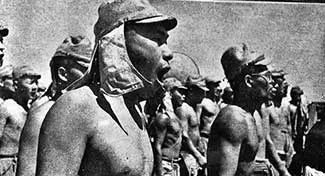The Sack of Barrio Cumba, Lipa in 1945 and the Treason Case vs Leandro Gonzales
[In this page: Lipa City, Barrio Cumba, Makapili, Treason, World War II]
⚬ “During the night of December 31, 1944, some twenty persons including some boys were caught in a surprise raid. They were taken to the Japanese Army camps. Only a few managed to escape. The rest were killed.
⚬ “The mass raid in Sampalucan, a sitio of the barrio, occurred in the early morning of February 19, 1945. About sixty innocent persons, mostly old and weak, were killed in this raid. They were tied and stabbed with bayonets.”
The document is just one of many archived at “the National Library of the Philippines as Historical Data,” solicited from Department of Education districts around the Philippines in 1951 to help reconstruct local histories destroyed during World War II. These “histories” are not entirely reliable because the stories were pieced together mostly from interviews of local folks; and memory, of dates in particular, can be very unreliable. What these “historical data” provide are starting points for further research.
In the case of the commission of atrocities by the Japanese at Barrio Cumba, the first one which happened on New Year’s Eve 1944 is corroborated by a Supreme Court decision dated 1948 on a case of treason filed by the People of the Philippines versus one Leandro Gonzales2, presumably a member of the pro-Japanese group “Makabayang Katipunan ng mga Pilipino” (Patriotic Organization of Filipinos), more widely known simply as “Makapili3.”
That night, Gonzales allegedly participated in a raid on Barrio Cumba
“by a patrol of Japanese soldiers and other Filipino followers and on that occasion apprehended fifteen persons and brought them to barrio Mataas-na-Kahoy4 of the same municipality.
The 19 February raid was not mentioned in the Supreme Court decision; but there was another incident that was. On 27 February, Japanese soldiers returned to barrio Cumba with the intent of flushing out guerrillas from among the barrio folks. On mere suspicion that the residents of certain houses were clandestinely members of the guerrilla movements, the Japanese soldiers and their Filipino followers, including Gonzales, burned down these houses.
Readers need to understand that by the end of February 1945, Japanese soldiers in Batangas had started to get really fidgety. For one, the Japanese Imperial Army was staring defeat in the eye in Manila at the hands of the United States Sixth Army, which landed on the shores of Lingayen in January and raced south to liberate the capital from Japanese occupation. Secondly, the United States Eighth Army landed on the beaches of Nasugbu almost a month before and it was a matter of time before the operations to liberate Batangas were to commence.
Witnesses described how the houses were burned:
“ Fidel Hernandez testified that at about 10 o’clock a.m. of February 27, 1945, he saw the accused and companion, with rags and gasoline, burn his (Fidel Hernandez’s) house, and that of Crisanto Mendoza, Julian Sara and Enrique Sara. Remigia Lorzano stated that at about 6:30 a.m. of the same day she saw the accused igniting a piece of rag and setting her house, as well as the houses of her brother-in-law and her two cousins, on fire. The last witness, Marcelo Peña, testified that at about 9 o'clock a.m., he saw the accused and companion pour gasoline on the houses of Asuncion Hernandez, Benito Hernandez, Sofia Katigbak and Melquiades Garin and burn said houses afterwards.”
⚬ While thirteen of the fifteen people who were apprehended from Barrio Cumba and then taken to Mataasnakahoy on New Year’s Eve 1944 were in most likelihood killed because they were never again seen, there was no evidence to indicate that Gonzales had actively participated in the killing.
⚬ Citing a precedent (People v Adriano), while in most likelihood Gonzales set fire to the houses as mentioned in the testimonies of Hernandez, Lorzano and Peña, there was only one witness to each burning incident. From the precedent, the Supreme Court wrote: “It is necessary to produce two direct witnesses to the whole overt act. It may be possible to piece bits together of the same overt act; but, if so, each bit must have the support of two oaths.”
2 Most of the details of this article were taken from “People of the Philippines vs Leandro Gonzales,” online at the LawPhil Project.
3 “Makapili,” Wikipedia.
4 The reference to Mataasnakahoy as a “barrio” is, of course, erroneous. It formally separated from Lipa in 1932 to be a distinct municipality. “Mataasnakahoy, Batangas,” Wikipedia.

